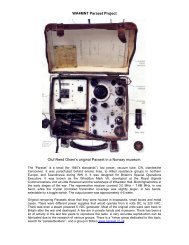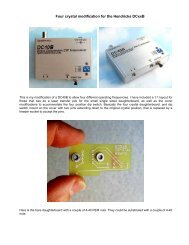Small Magnetic Loop Antenna Project - QRPBuilder.com
Small Magnetic Loop Antenna Project - QRPBuilder.com
Small Magnetic Loop Antenna Project - QRPBuilder.com
Create successful ePaper yourself
Turn your PDF publications into a flip-book with our unique Google optimized e-Paper software.
The larger bore 2-inch LDF750 can be used on the lower bands to beyond 1 kW. In<br />
relation to resistance and conductivity, small loop antennas inherently exhibit very low<br />
radiation resistances, which <strong>com</strong>pete with the ohmic resistances of the loop conductor and<br />
the resistances from connections and welds, including the tuning capacitor connection.<br />
<strong>Magnetic</strong> loop antennas will typically have a radiation resistance in the order of 100 to 200<br />
milliohms. This means that every additional milliohm caused by a poor contact will cost<br />
you one percent efficiency. That is why professional magnetic loop antennas for<br />
transmitting purposes will never have mechanical contacts and everything including the<br />
capacitor plates should be welded or silver soldered. It is not un<strong>com</strong>mon to experience 60<br />
Amperes or more of RF circulating current in the loop and capacitor when fed with several<br />
hundred Watts of power.<br />
In the practical deployment and siting of a loop antenna there are extrinsic factors of both a<br />
beneficial and deleterious kind affecting the radiation and loss resistances when the loop is<br />
not strictly deployed in a free space scenario. When the loop is mounted over a perfectly<br />
conducting ground plane reflector or copper radial wire mat an electrical image is created<br />
that increases the effective loop area. This increase in turn beneficially increases the loop’s<br />
radiation resistance by a substantial factor. Such a favourable situation is easy to facilitate.<br />
Conversely if the loop is placed over average ground (a reasonable reflector) the radiation<br />
resistance increases but a reflected loss resistance is also introduced due to transformer<br />
effect coupling near-field energy into the lossy ground. Similarly when ferrous / iron<br />
material is too close, the magnetic near-field of the loop will induce by transformer action<br />
a voltage across the RF resistance of the material causing a current flow and associated I 2 R<br />
power loss. This situation might for example arise when the loop is mounted on an<br />
apartment balcony with nearby iron railing or concrete rebar etc; the deleterious influence<br />
can be minimised by simply orienting the loop to sit at right angles to the offending iron or<br />
steel material. Another loss contributing <strong>com</strong>ponent is due to current flowing in the soil via<br />
capacitance between the loop and the soil surface. This capacitive coupling effect is again<br />
minimised by keeping the loop at least half a loop diameter or more above the ground.<br />
The transformer analogy for the loop antenna is a good one. The HF <strong>com</strong>munication link<br />
may be visualised as a reciprocal “space transformer” with the loop acting as a secondary<br />
“winding” loosely coupled to the distant transmitting antenna. The magnetic field<br />
<strong>com</strong>ponent of the incident electromagnetic wave induces a small RF current to flow in the<br />
loop conductor by means of induction that in turn gets magnified by the loop resonator’s<br />
high Q that’s appropriately impedance matched to the coax transmission line.<br />
A freestanding transmitting loop is best supported a metre or two in height on a short nonmetallic<br />
mast section of 100mm diameter PVC drainpipe and pedestal foot fashioned from<br />
plastic plumbing fittings. The loop can also be placed on a rotator drive plate and turned<br />
for best signal strength or it can be oriented in angle to null-out particularly bad QRM.<br />
Care must be taken not to touch the loop when transmitting and to keep a safe distance<br />
away from the loop’s magnetic near-field to ensure conservative <strong>com</strong>pliance with<br />
electromagnetic radiation / EMR standards for human exposure to EM fields. A distance<br />
equal to or greater than one or two loop diameters away is generally a safe field strength<br />
region. RF burns to the skin from touching the loop while transmitting are very unpleasant<br />
and take a long time to heal.<br />
10





